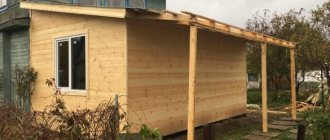Expansion of living space can be done not only through redevelopment and demolition of partitions. One popular option is to build an extension. For apartment buildings, the extension looks like a balcony on the ground floor. For a cottage, expansion through attached verandas or rooms.
Few people know that the legality of an extension to an apartment building or cottage still needs to be proven. Otherwise, such buildings are subject to demolition. We will consider below what needs to be done in order to obtain permission to add an extension to an apartment building.
Dear readers! Our articles talk about typical ways to resolve legal issues, but each case is unique. If you want to find out how to solve your specific problem, please contact the online consultant form on the right. It's fast and free! Or call us at 8(800)-350-30-02 (the call is free for all regions of Russia)!
What kind of extension is possible?
Most often, people build a loggia or balcony. In case of influence of the building on those. side of the building you need to obtain official permission or apply through judicial organizations.
A permit to leave the extension can be obtained from the official commission of the technical bureau. inventory.
A permit is issued if the extension is no more than 12 meters from the building, can be easily and quickly dismantled, or does not contain a solid foundation.
The agreement on the decision to leave the large extension is taken by the owners of all apartments in the apartment complex at an official meeting by voting by residents. If it is not possible to organize a meeting, collecting signatures is used as an alternative.
ATTENTION! Obtaining permits from other owners is also necessary when constructing an extension to an apartment building (barracks) or a two-apartment building.
How to legitimize when planning construction
Compliance with the requirements of the law at the planning stage of the future construction process is the main way to legally register the erected extension.
Contacting the appropriate authorities that consider cases of this nature is the first step in this direction. The best option is to submit an application to a construction company.
Attention! It is important that the organization is licensed, otherwise there is a risk of becoming a victim of scammers. The draft construction project will be developed on the basis of existing technical documentation.
According to the requirement to take into account relevant standards, it is possible to contact various organizations to confirm certain requests.
After this, the project, available with an official application and relevant documentation, is submitted for consideration to local administrative authorities or other authorized services.
A special commission submits the project for review, checking for the presence/absence of technical errors.
Official approval for construction work is subject to the relevant provisions of the above-mentioned structures. After this, construction can begin.
Its completion is marked by the arrival of an authorized commission that checks the final structure for compliance with previously stated standards and compliance with all legal acts.
Only after receiving the act, the owner has the right to contact the Technical Inventory Bureau to make amendments to the technical documents.
Varieties and documentation
According to generally accepted standards, extensions are divided into two main types:
- non-permanent - this is the name given to reconstruction buildings that do not have a solid foundation as a basis. For example, the porch or stairs of a large building located on the street. This category also includes shop windows, terraces, canopies and other quickly disassembled and assembled extensions that do not have a solid base;
- capital. Balconies, verandas, loggias are the main types of permanent structures. They differ from non-permanent buildings by the real influence on the economic and technical properties of an apartment building, determined by the height, width and other parameters of the constructed structures.
The acceptance certificate is all that is required for registration of non-permanent buildings. There is no need to obtain special permits; construction can begin immediately.
But permanent buildings require more attention and a huge package of paper, which includes:
- Consent to construction from all residents of the building.
- Construction project.
- Living area plan.
- A document about who owns the property - agreement of purchase and sale, gift, inheritance, and so on.
- Approval from Rospotrebnadzor.
- Characteristics from the fire department inspection.
- Certificate from the Committee of Architecture and Urban Planning.
Once all the papers have been collected, submit your application to the administration. In any case, management must approve your project so that you can begin construction. Many people immediately come to the court with an application, believing that this way they will receive a positive decision faster.
It should be noted that the city or district administration may issue a refusal. Here are the main reasons:
- If the apartment building is located in the city center and is considered an architectural monument.
- If the construction will destroy the house and worsen its visual appearance.
- If the project is agreed upon, but old technologies and materials will be used in its creation.
Having received permission from the administration, begin construction immediately. And after work, be sure to draw up an acceptance certificate and contact the technical office. inventory. It is from the BTI that you must receive an official conclusion on the redevelopment of the living space.
Application procedure
Registration of a building structure considered as an adjoining building is the prerogative of specially authorized bodies. The application procedure is determined by the classification of the extension.
On the way to legitimizing the extension, the first service to which contact is mandatory should be local administrative authorities.
In most cases, administrative services have an architectural department, whose specialists have the rights and authority to coordinate construction work.
The Architectural Department is the first and most desirable authority to which applicants should submit applications regarding both an extension being prepared for construction and one currently at the completion stage.
The final decision is made by a specially selected commission, whose members arrive at the site at the location of the house with an extension.
They draw up an act confirming the compliance of the constructed structure with basic building codes.
But this procedure is possible only after the successful completion of a check to compare the final structure with the draft project, which, in turn, is carried out after confirming the availability of a special permit to carry out restoration work.
The owner of the house has the right to change technical documents and register private ownership of the housing complex in accordance with the conclusions of the act.
Attention! Our qualified lawyers will assist you free of charge and around the clock on any issues. Find out more here.
Submitting an application after the successful completion of the construction process is still a valid reason to submit a formal application to the local administrative authorities.
Since the developer does not have a license to carry out construction work, the administration refuses to legalize the extension.
After this, the owner has the right to apply to the court to obtain the right to officially legitimize the constructed construction. The outcome of the case will depend solely on the court's decision.
Watch the video. How to legalize the construction of a balcony on the first floor:
Algorithm of actions
Even if you built a non-permanent structure a long time ago, you can legalize it at any time. The registration procedure is quite easy and is represented by a list of the following steps:
- collection of papers confirming the owner’s authority to own housing;
- Formation of an appeal for amendments to technical requirements. documentation;
- submitting an application to the BTI at your place of residence;
- the arrival of an official commission at the site, which will resolve the issue and draw up an act on the reconstruction of the building;
- receiving new papers;
- applying to the Russian Register to formalize the changes made.
In the case of permanent buildings, the registration procedure is the same, but differs in the need to submit an application before the start of construction work. This fact will serve as a reason for the special commission to act on the re-introduction of housing into operation by the owners. Making changes to those also depends on this. construction documentation.
ATTENTION! Unauthorized construction of a major extension to an apartment building is not only considered illegal, but also cannot be started due to the need to apply to judicial organizations.
What documents will you need?
Important! Obtaining permission to build an extension to an apartment building requires the following documentation:
- legal papers confirming the legal right of the owner to the plot of land on which the house stands;
- regulations in home ownership;
- technical characteristics of the building, including house plan and inventory assessment;
- information on the composition of registered owners;
- official approval of residents for the construction of an extension;
- coordination with local housing and communal services authorities. Necessary due to the fact that most capital structures affect engineering communication lines and to coordinate construction processes at a preliminary level;
- diagram of the MKD under consideration, taking into account the changes made;
- documentation from the sanitary and epidemiological service confirming the acceptable level of compliance with sanitary and epidemiological standards in force for residential premises;
- documented permission from the owners of similar land plots only in the event of a construction structure touching their territory;
- photographs and (preferably) video materials of an apartment building and land plot (if necessary);
- documented permission for consent and construction work from public services such as Fire Supervision, Gas Service and other organizations is not mandatory, but is recommended as an additional argument.
Shop or loggia
Often, under the guise of a balcony, owners add an additional one. a room to an apartment, a store with a basement, a snack bar or an office.
In any case, it is worth legitimizing a non-residential extension, just like a residential one.
The main reason is that the building will have a foundation or a load-bearing column type. It should be emphasized that legalizing a non-residential extension to a large building is a complex process.
Initially, because such a structure will be built illegally - it will be located on a plot of land owned by the municipality, and not the owner of the property. But statistics show that owners can ensure that a loggia or store becomes a separate property.
What needs to be done:
- Reconstructs a building without affecting the load-bearing parts. Let's form a conclusion about this.
- We prepare tech. documentation. If this is a store, then the package of papers must be collected for a separate property. And if it is a balcony or loggia, then to the main living area and non-residential area.
- We take the documentation to the cadastral chamber or administration. If they do not issue a permit for the facility, then we go to court with questions.
A loggia and a balcony, naturally, will not raise any questions. You can easily register them, even without the consent of your neighbors. But there are a lot of problems with the store. The land for real estate will be quite difficult to win back from the government. But many administration employees help and sell plots to homeowners.
Terms of approvals
The terms of survey and design for the upcoming extension are determined by agreement. They depend on the terms of the technical specifications, the features of the upcoming work and the characteristics of the original object. Review of documents by Gosstroynadzor takes no more than 7 days. After completion of the work, the technical plan can be obtained from our company within 1-5 days. More information about the timing of procedures and registration of mandatory documents can be found by calling us.
| No. | Service, document | Price |
| 1 | Development of a reconstruction project | from 350 rub./sq.m. (depending on the total area of the building) |
| 2 | Examination of design documentation | Calculated according to Decree No. 415, depends on the type of project, type and area of the building |
| 3 | Support of approval and obtaining permits at Gosstroynadzor | from 30,000 rub. |
| 4 | Support of cadastral registration and registration | from 15,000 rub. |
| 5 | Conducting engineering surveys and site inspections | from 30,000 rub. per hectare of land. |
Cost of the procedure
The cost of legalization is established through classification. In the case of registration of an unauthorized addition, if you do not call a lawyer for help, you will have to seriously spend money.
The usual cost in such a situation is 1000 rubles, but this amount may vary depending on the region and the lawyer. The appearance of a specialist in court, at least once, can cost five thousand rubles.
As the number of meetings increases, the price of a lawyer’s services will increase exponentially. Legal representation team can vary from 25,000 to 30,000 rubles, in terms of cost.
Lawyers' recommendations
Here are a couple of tips from good specialists that will help you quickly understand the legalization and construction of structures:
- A balcony or loggia is usually legalized as non-residential real estate. If you do not do this, you will have to pay a fine of one to two thousand rubles every month.
- Contact the court only when you cannot obtain a permit from the administration. First get all the necessary papers from government organizations, be sure that your project is perfect. With other organizations the process may take a long time.
- The extension should be located two meters from utilities . An underground communications plan is issued by the Committee for Architecture of your locality.
- If your extension touches someone else's land, try privatizing this land . According to the residential complex, the entire territory next to the large building is the property of all residents. In addition, the land may belong to the state.
- It is better that the building is designed as a separate object. Find out if the extension can be separated from the main building, and then collect the necessary paperwork. In addition, find out whether the land can be registered as an independent piece of real estate.
There is a cafe on the ground floor of an apartment building and an extension was built to it
It is necessary to obtain consent for reconstruction from all owners of premises in an apartment building (for example, at a general meeting of owners or by collecting signatures). Since the balcony will be attached to the apartment on the ground floor, it may also impede access to the land plot, which is in the common shared ownership of the owners of the premises in the apartment building, which also means the need to obtain their consent for reconstruction.
Local government bodies do not have the right, without the consent of the owners of privatized apartments, to sell, rent out or resolve issues of reconstruction, superstructure, addition to structures, building staircases and entry/exit gates, installing special technical equipment for industrial purposes on the facades of houses, etc. ., with the exception of carrying out repair work in accordance with the law.







